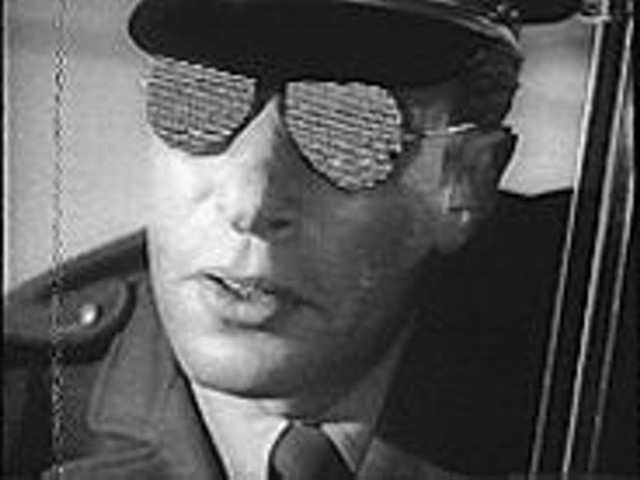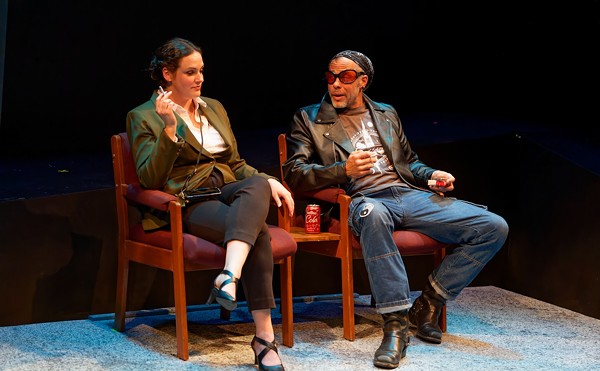Our story begins in innocence, as the joyful "Odun De" calls the audience into communion with the actors. With a seamless physical transition, the performers portray capture and enslavement as the music transforms into a plantation work song. No words are spoken, or needed, as the tale tells itself achingly through muscle and vocal tones. The first act is a marvel of acoustic music, ranging from the breathtaking four-part male harmony of "Child of the Most High King" to a spoon-tapping, washboard-rapping, tambourine- and banjo-licking "Who Broke the Lock" and ending with a spirited "Catch on Fire."
The music gets "plugged in" for the second act, which moves the Southern blues up north to "Sweet Home Chicago," where the blues gets down and dirty (to squeals of joy from the audience). We watch melodies mature and step out of expected boundaries, embracing bluegrass and pop but never forgetting their roots. The most compelling moment comes late in Act 2, when the show's musical director and co-creator, "Mississippi" Charles Bevel, tells us that we can't pay homage to the blues without examining the "Mississippi of the heart." This place is embodied in "Strange Fruit," a Billie Holiday song that was banned from radio play. Kim Massie sings of the horror: "Southern trees bear strange fruit, blood on the leaves, blood at the roots. Black bodies swinging in the Southern breeze -- strange fruit on the poplar trees." The audience is breathless. Without a pause, the company responds with "Some Day We Will All Be Free." The emotional shift is stunning -- the point made without didactic dialogue -- the dual truths of despair and hope are communicated through our hero, the blues.
Embodying these blues are seven outstanding performers and four band members who perform 40 songs. Bevel and Tom L. Hall are musician/singers, moving easily between accompanying and solo work. Bevel shines with "The Walking Blues" and "I Can't Stop Loving You." Hall is occasionally hard to hear as a soloist but wins our hearts with "Candy Man." J. Samuel Davis stops the show with "I'm Your Hoochie Koochie Man," a pelvis-grinding song promising sexual satisfaction. "Get that mojo working!" a woman yelled as he began the song, and his response elicited screams of delight as he demonstrated his gyrating gris-gris. Gary Vincent had several great solos but will be remembered by the ladies in the audience for his sly, smooth sensuality in "Crawlin' King Snake."
The women of the company -- Massie, Denise Thimes and Heather Dawn -- move between lighthearted and gut-wrenching solos, with some excellent trio work thrown in for good measure. Massie's highlights include "St. Louis Woman" and "I Know I've Been Changed." Dawn pays tribute to Mae West (whose vaudeville act mimicked the black women singers of the time) with "Now I'm Gonna Be Bad." Thimes is not to be trifled with in "Someone Else Is Steppin' In" and "I Put a Spell on You." The cast, joined by band members Charles C. Brown, Keith Gamble, Jimmy Hinds and Richard Hunt, are rock solid -- the depth of talent here is truly remarkable.
If you think that the blues are just sad songs, you haven't been paying attention. In the final analysis, the blues are about love -- not that sappy pop-song, Hallmark-card kind of love but the real thing in all its guts and glory. Blues is love in its hard-to-find, hard-to-hold-onto form; love in its sweaty, unpredictable, painful exhilaration; love for home, God, family, lovers. What makes this production outstanding is that the performers share these blues, in all their humor and anxiety, lovingly with the audience -- and the audience responds in kind. The give-and-take between performer and viewer is tangible, an example of the uniquely immediate experience of theater. Director Ron Himes brings us an energetic production that claims to be "nothing but the blues" but is in reality a tribute to the essence of what it means to be human.





